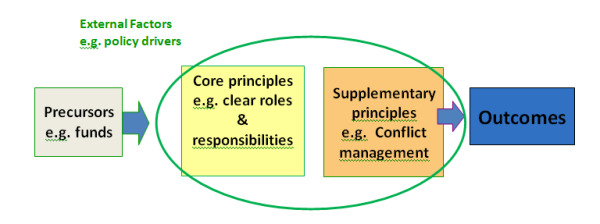Putting 'Good Practice' in Context - Lessons for Catchment Management
Published on 6 December 2011 in Sustainability and Communities , Climate, water and energy , Ecosystems and biodiversity
Introduction
In recent years, collaborative and cross-sectoral approaches have been recommended as the most effective and equitable way to achieve better water quality in catchments. However, the realisation that such an approach is often the right thing to do does not mean that this is a simple and predictable process.
Previous research has identified several factors that promote collaborative management success including the use of adaptive management approaches, good communications between stakeholders and management of conflictive situations. However, critical assessment of past case studies shows that following good practice processes may not always result in successful outcomes (e.g. increased engagement, sustainable process, improved water quality) as other factors can intervene such as lack of funding, poor coordination, and difficulties in maintaining engagement with key stakeholders. This research addresses the need to understand the factors that may influence the efficacy, efficiency and equity of such processes.
Key Points
Catchment management experiences teach us that good practice cannot be represented as a rigid set of rules. Instead, it is more useful to define good practice as a framework describing the relationships between different elements.
These elements include the precursors to any catchment management process; the external factors impacting on a process over time and the principles themselves (see Diagram 1). These all affect the degree to which a collaborative catchment management process might be able to make use of good practice principles. A coherent and well managed process may not achieve its overall objectives due to external factors such as lack of finances or ability to retain staff, poor stakeholder buy-in, or inadequate data. Related policy areas (e.g. planning, agriculture, hydro-electric renewables, habitats and species, and forestry) also influence catchment management processes. For instance rural policy payments for land management might facilitate catchment management objectives being met, while policy drivers promoting micro-hydro schemes may impact on the priority given to improving ecological status within a catchment.
We find that the principles fall into two categories, which we describe as core and supplementary. Core principles such as clear decision-making processes or clearly defined and agreed roles and responsibilities were common to, and seen as necessary by all of the case study processes. Supplementary principles (e.g. good communication flow, accommodation of related issues, conflict management) were seen as enabling a process, but not to be a central requirement in all cases, being more context specific.
Different catchments have different characteristics including number of issues to be addressed, spatial scale, the driver for change (e.g. legislatory, organic, conflictive). This means that each process needs to apply good practice as appropriate to its setting, and be evaluated with consideration given to this.
Diagram 1. The application of principles of good practice in collaborative catchment management are dependent on the precursors on which a process is based and the external factors influencing it.

Research Undertaken
A desk study on 29 catchment management processes illustrated that they operated over different timescales, with different objectives, levels of funding, staffing and stakeholder engagement, and for different rationales. Interviews were conducted with catchment officers and steering group chairs (N = 15) for eight of these processes. This provided improved understanding of the catchment management project cycle, and provided data often not publicly available. See Marshall et al. (2010), for more detail.
Policy Implications
River Basin Management Plans have been developed for Scotland under the EU Water Framework Directive (WFD), with many catchment specific, stakeholder led management processes (CMP) continuing to operate alongside.
In both the WFD and the CMP processes, statutory agencies and policy makers have a part to play in creating conditions that facilitate ‘good practice’ being followed. Such agencies need to be responsive to the context-specific needs of the catchments or basins which are influenced by such things as the different prioritisation of issues, the degree of engagement with relevant stakeholders and their geographical location and scale. Where top-down policy drivers such as WFD meet more bottom-up CMP processes it might be possible to identify common goals and use resources more efficiently, but the institutional arrangements required to achieve these are likely to take time and effort to develop. All those involved need to be aware of this and the many factors which impact on the ability of CMP processes to deliver improvements to the catchment.
Any evaluation of a catchment management process needs to take into account the principles, precursors and external issues which have affected the process’s ability to achieve outcomes, and not judge all processes as though they operated within the same sets of constraints.
Authors
Marshall, K. keith.marshall@hutton.ac.uk
Blackstock, K. L. kirsty.blackstock@hutton.ac.uk
Waylen, K. kerry.waylen@hutton.ac.uk
Dunglinson, J. jill.dunglinson@hutton.ac.uk
Topics
Sustainability and Communities , Climate, water and energy , Ecosystems and biodiversity





